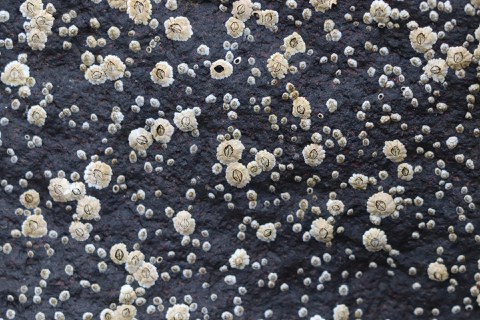13.08.2024
Tierisch Reich: Seepocken - Kostenspielige Krustentiere für die Schifffahrtsindustrie

Seepocken heften sich nicht nur an natürliche Oberflächen sondern auch an Schiffsrümpfe von Containerschiffen. Dort werden sie zu einer kostspieligen Angelegenheit, da sie den Treibstoffverbrauch der Containerschiffe erhöhen.
Etwa 80% der weltweit gehandelten Güter werden auf Containerschiffen zwischen den Kontinenten transportiert. 2022 entsprach das 1200 Milliarden Tonnen Waren und Güter. Das macht die Frachtschifffahrt zu einer wichtigen Komponente im globalen Handel [1]. Ein vielleicht etwas unerwartetes, aber dennoch sehr großes Problem der Seeschifffahrt ist: die Seepocke.
Seepocken kennen die meisten wahrscheinlich als kleine harte Beulen, die überall an Felsen im Salzwasser zu finden sind. Aber nicht nur an Gestein, Seepocken haften zum Beispiel auch an Schildkrötenpanzern oder Walhaut [2]. Obwohl sie mit ihrem harten Panzer an Muscheln erinnern, gehören Seepocken zu den Krebstieren. Als Larven heften sie sich unter Wasser an harte Oberflächen, wo sie sich dann zu den Seepocken entwickeln, wie wir sie kennen. Sie bilden eine harte Schale aus, die ihren weicheren Körper bedeckt [3]. Wer schon mal versucht hat eine Seepocke vom Fels abzupulen weiß, die Seepocke sitzt bombenfest. Das liegt am spezielle wasserfeste Biokleber, den die Larve bei der Anheftung bildet. Er besteht aus verschiedenen Proteinen [4]. Wann und wo sich Seepocken ansiedeln, hängt von verschiedenen Umweltfaktoren ab, die der Larve gute Lebensbedingungen suggerieren [3]. Sie bleiben dann für den Rest ihres Lebens an dieser ausgewählten Oberfläche [5]. Seepocken heften sich nicht nur an natürliche Oberflächen, sondern auch an Schiffsrümpfe, wo sie für die Schifffahrtsindustrie zu einer kostspieligen Angelegenheit werden. An der Außenseite eines Schiffes gehaftet, erhöhen die Seepocken die Oberflächenrauheit des Schiffes. Dadurch erhöht sich der Reibungswiderstand des Schiffes im Wasser, was zu verringerter Geschwindigkeit, längeren Fahrten und schließlich zu einem höheren Treibstoffverbrauch führt. Allein für die US-amerikanische Schifffahrtsindustrie könnten durch den erhöhten Treibstoffverbrauch Kosten von mehr als 30 Milliarden US-Dollar pro Jahr entstehen [6].
Schon nach 6-monatigem Betrieb erhöht sich der Treibstoffverbrauch von Schiffen um etwa 30-50% [7]. Um die maximalen Kosten der Seepocken für den weltweiten Warenverkehr abzuschätzen, gehen wir nun von einem 50%igen Anstieg des Treibstoffverbrauchs aus. Ein 8000 TEU Containerschiff, ein Schiff Stellplätzen für 8000 Container, verbraucht bei normaler Geschwindigkeit (20-25 Knoten oder 37-46 km/h) 225 Tonnen Treibstoff pro Tag [8]. Die Kosten für eine Tonne Treibstoff liegen bei etwa 700 US$ [9], so ein großes Schiff verbraucht also Treibstoff im Wert von 158.000 US$ pro Tag. 50% höherer Treibstoffverbrauch durch Seepocken, kostet dann also etwa zusätzliche 79.000 US$, pro Tag. Um die zusätzlichen Gesamtkosten für alle im Jahr 2022 auf dem Seeweg transportierten Güter (1200 Milliarden Tonnen) zu berechnen, nehmen wir nun der Einfachheit halber an, dass alle Güter auf 8000 TEU-Containerschiffen befördert wurden. Ein 8000-TEU-Containerschiff kann schätzungsweise ein Volumen von etwa 87.000 Tonnen befördern [10]. 2022 lag das tägliche Handelsvolumen bei 3,3 Milliarden Tonnen. Um das zu befördern, wären jeden Tag 38.000 Containerschiffe benötigt. Bei jedem Schiff entstehen jeden Tag die oben berechneten zusätzlichen Kosten von bis zu 79.000 US$ durch Seepocken.Bezogen auf die Daten von 2022 hätten die sesshaften Krebse zusätzliche Treibstoffkosten von etwa 1000 Milliarden US$ für das gesamte auf dem Seeweg beförderte Handelsvolumen verursacht. Und das nur, weil sie den Widerstand auf der Schiffsoberfläche erhöhen.
Neben den zusätzlichen Treibstoffkosten ist die Entfernung der Seepocken von Schiffen eine weitere kostspielige Angelegenheit. Schiffsrümpfe können entweder frühzeitig beschichtet werden, um das Anhaften von Seepocken zu verhindern, oder sie können von Seepocken befreit werden. Für Schiffe der US-Marine wurden die Kosten der Beseitigung des so genannten Biofoulings geschätzt. Dazu gehören Algen, Seepocken und andere Schalentiere. Die Gesamtkosten für Rumpfbeschichtungen, Reinigung und Antifouling eines bestimmten Modells von US-Schiffen, das 30 % der Schiffe der US-Marineflotte ausmacht, werden auf 56 Millionen Dollar pro Jahr geschätzt. Für die gesamte Flotte der US Navy, belaufen sich die ungefähren Kosten für den Bewuchs des Schiffsrumpfes auf 180 bis 260 Millionen Dollar pro Jahr [11]. Die Reinigungskosten können je nach Schiffsgröße, Reinigungsmethode und Schwere des Biofoulings erheblich variieren. Das Abkratzen eines Quadratfußes Rumpfoberfläche kann ungefähr 4,50 US$ kosten [12], was etwa 49,5 US$ pro m2 entspricht. Ein einziges 8000 TEU Containerschiff mit einer Unterwasserfläche von etwa 16.644 m2 [13] von Bewuchs zu befreien würde also 824.000 US$ kosten. Anhand dieser hypotetischen Berechnung ist davon auszugehen, dass die Reinigung aller Schiffe von Biofouling zusätzliche Kosten in Höhe von mehreren Millionen US$ für die Industrie verursacht.
Zusätzlicher Treibstoff, Spezialbeschichtungen der Schiffe oder Schiffsreinigung - auch wenn sie harmlos aussehen, kosten Seepocken die Schifffahrtsindustrie mehrere Milliarden Dollar jedes Jahr. Trotz der wirtschaftlichen Folgen, die sich aus dem Lebenszyklus der Seepocken ergeben, können wir auch von ihnen lernen. Der Klebstoff der Seepocke ist wegen seiner starken Klebeeigenschaften unter Wasser ein spannendes Forschungsgebiet der Bionik [14]. Dieser Kleber, der Feind der Schifffahrtsindustrie, kann als Gewebekleber verwendet werden, um Wunden schnell zu verschließen und ihre Heilung zu fördern [15]. Was können wir daraus lernen? Es gibt immer zwei Seiten einer Medaille.
Min Mao, Sophie Merz, Helen Rothfuß, Übersetzung Nele Kheim
Issue 25 (PDF)
